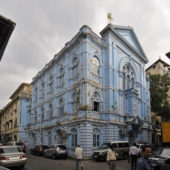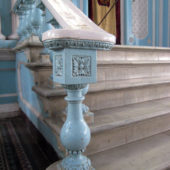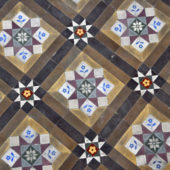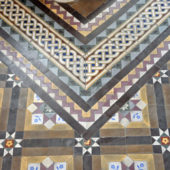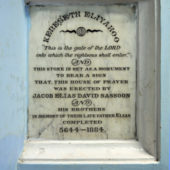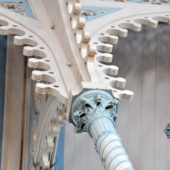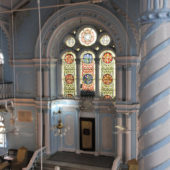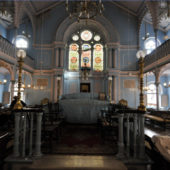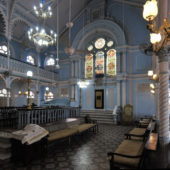Built by the famous Sasoon family in an decorative Victorian style, the Kneseth Elyahoo synagogue is an important destination for tourists in Mumbai.
David Sassoon (1792-1864), founder of the Sassoon dynasty in India, and of the Keneseth Eliyahoo Synagogue, fled persecution of the Pashas (Ottoman Turks) to India through Bushire in Iran, together with his father, who died there. David Sassoon and his family of eight children founded an international empire of trade and commerce, selling carpets, running a counting house, and obtaining a monopoly on the opium trade in China. He subsequently established many educational, religious and charitable institutions in Mumbai and the Pune Jewish community. As well as synagogues, he built a hospital, orphanages, libraries, museums, docks, schools, an infirmary, and a leper asylum.
Keneseth Eliyahoo Synagogue was built in 1884 by Jacob Elias Sasson and his brother Albert, in memory of his father, Eliyahoo Sassoon (son of David). The Synagogue is situated in the central area of Mumbai, within twenty minutes taxi ride from many fine hotels such as the Hilton, Oberoi and the famed Taj Mahal. The majority of Jews in the community are of the Bene Israel bloodline. In the early years after its construction, a large Bagdadi Jewish community lived in the area and the more affluent members lived near the Synagogue. The Jewish Club and David Sassoon Library were close to the Synagogue. On High Holidays the Synagogue would be completely filled. The women of course, were seated upstairs in the women’s gallery. After 1941 there was an influx of Jews to Mumbai from Bukhara, Persia and Iraq, adding further members to the Synagogue. Today, Keneseth Eliyahoo Synagogue caters to the local Jewish community and to foreigners who visit Mumbai from all over the world. There is a regular Minyan (service) on Sabbaths (Saturdays) and the eve of Sabbaths (Friday nights), as well as on High Holidays. Keneseth Eliyahoo has had a Kosher mikvah (ritual bath) for over one-hundred years and people would travel from Asia to enjoy the mikvah.
The finely detailed Victorian façade features stone below and brick above and is painted a spectacular sky-blue color, offset with white molding. Inside, the massive prayer room features sky blue walls with white detailing, with a white ceiling boasting sky blue detailing. Arched windows flank the side-walls and the women’s gallery surrounds the sanctuary’s side and back walls, boasting Victorian paneling in sky blue and white, with dark wood hand-railing. The gallery is supported by elegant, spiraled columns with Corinthian capitals reaching from the ceiling to the floor. Intricate and beautifully worked supports and Victorian detailing is evident throughout the sanctuary. The bema is in the center of the prayer room, featuring a wood floor, and is surrounded by a white balustrade with dark wood hand railing. The tivah (reader’s desk) is placed inside and a chandelier drops from the ceiling above the bema. Against the west wall, in a huge arched inset, is the Aron Kodesh flanked by carved marble pillars, up a few steps on a small platform. It is comprised of panels of sky blue and white. Torah scrolls are encased in silver, hidden behind the drawn Torah curtain. Magnificent arched and round stained glass windows rise above the Aron Kodesh, within the arched inset. Above the inset are two tablets, with The Ten Commandments inscribed upon them in Hebrew. Wood pews sit on Victorian tiled flooring. The Synagogue building also contains an elementary school and community center.
In 2009 the Synagogue celebrated its 125th Anniversary, where the President of India, the Governor of Maharashtra and the Ambassador of Israel to India, amongst other dignitaries, attended. Although many of the Jewish community emigrated to Israel after 1948, the Synagogue is still active and well maintained.
For more information see http://www.wmf.org/project/keneseth-eliyahoo-synagogue

